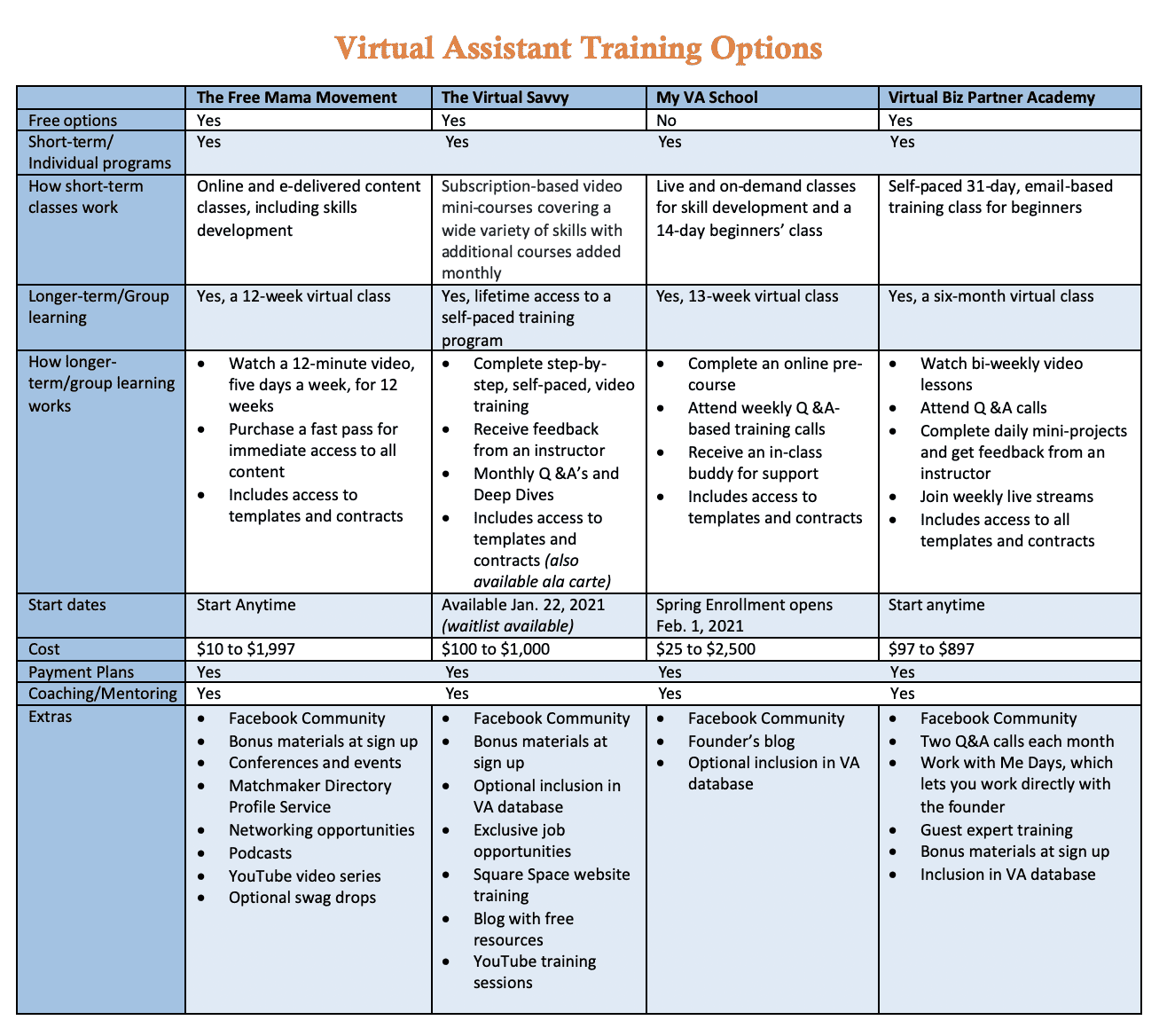How to Select the Best Virtual Assistant Training Program for You

If you’re ready to work from home, start your own business, or launch a side hustle, consider becoming a virtual assistant (VA). As a VA, you take care of many tasks, including email response, appointment setting, travel planning, and calendar management. You can work as a general VA, who does a wide variety of tasks or become one with a specialty in a particular industry or need.
VA work is catching on quickly. This summer, Kevin O’Leary from the hit NBC show Shark Tank said that if he had to start a side hustle right now, he’d launch a VA business. He explains that it’s a great business model because it solves a problem so many people have–squeezing more tasks into a day. It’s also an excellent lifestyle for moms who want to control their own time, skip the commute, and put family first while still keeping professional ambitions alive.
Like many things in life, the first step is the most difficult. Luckily, training can help. The right training at the right time can make all the difference to your journey, so selecting the right system can help you get started in the right direction. At HireMyMom.com, we’ve rounded up the best training options to help you get started. You can find an overview of the options and a framework for picking the right program below.
Pick the Right Training
The four options we have partnered with include:
- The Free Mama Movement
- The Virtual Savvy
- My VA School
- Virtual Biz Partner Academy
All of these programs are excellent. You can’t go wrong. Each provides:
- Entry-level classes that cover the basics to help you get started.
- More extensive classes to help you scale your work as you are ready.
What to Consider as You Choose Training
Selecting the best training option will depend on many individual factors. Each training program and system offers a unique style, and a quick visit to each website will quickly introduce you to the feel of the product, so you can find the one that best meshes with your personality. Other differences include the timing, the extras, and the cost. An overview of each option appears below so you can contrast the possibilities and determine what’s right for you. As you review the round-up, consider your:
- Goals
- Availability
- Budget
- Preferred learning style

The Free Mama Movement
Developed by Lauren Golden, she hosts many of the programs available and shares her story.
Program options: This training program offers three options:
- Free modules, which include a three-part introduction to working as a VA.
- A 12-week virtual class that you can start anytime. Includes a wide variety of bonus materials.
- Independent and add on classes, such as the Quick Start Program or the 90 Day Accelerator.
How it works: The virtual class is comprised of a program delivered in 12-minute video increments, five-days a week for 12 weeks. You can purchase a fast pass if you want immediate access to all content.
Price: Anywhere from less than $10 to about $1,997, based on the components you select. Payment plans are available.
Extras: Conferences and events, networking opportunities, podcasts, and a YouTube video series are all available. You can purchase a subscription to a coaching circle for additional support. A Facebook Community is available. You can sign up for access to “swag drops” and participate in the Matchmaker Directory Profile Service.
The Virtual Savvy
Developed by Abbey Ashley, she shares her story about how she got started in this YouTube interview and serves as the host of many programs.
Program options: This training program offers three options:
- A free overview, which covers some basics along with free booklets and other materials.
- Lifetime access to a self-paced training program, available beginning Jan. 22, 2021. (A waitlist is available.)
- Supplemental classes, including a subscription to skills training options.
How it works: The self-paced class offers a step-by-step guide for setting up the business.
Price: Anywhere from about $100 to about $1,000, based on the components you select. Payment plans are available.
Extras: You can view a blog with resources to get started and free checklists and resources. A Facebook Community is available. Also, bonus materials are available at sign up. You can choose to be included in their VA database, access exclusive job opportunities, or view YourTube training sessions. Squarespace website training is available.
My VA School
Developed by April Herndon, she hosts many of the programs available and shares her story with us in this YouTube Interview.
Program options: This training program offers two options:
- A 13-week virtual class, guided by April. (Use coupon code hiremymom20 for 20% off all courses! — Spring enrollment opens Feb. 1, 2021.)
- Live and on-demand classes focused on skills training, including an e-mail-based VA training class. (Coupon code hiremymom20 for 20% off all courses)
How it works: The virtual class includes weekly Q&A calls and a private Facebook community to connect with April and other classmates. In addition, you’ll be paired with a buddy to help support you. A pre-course enables you to lay the foundation for taking the class. When the course concludes, you’ll have the option to be added to her Virtual Assistant Database to help pair you up with clients looking for a trained VA.
Price: Anywhere from less than $25 to about $2,500, based on the components you select. Payment plans are available.
Extras: A Facebook Community is available. April shares a blog, and you can purchase a private coaching call with April for specific questions, support, and brainstorming.
Virtual Biz Partner Academy
Developed by Sara Lingenfelter, she shares her story and her process with us in this YouTube interview.
Program options: This training program offers two options:
- Virtual Assistant Training, including bi-weekly classes over six months.
- The 31-Day VA Program, which is a self-paced option to help you get going quickly.
How it works: The virtual class uses a video format to share information. When you sign up, you also get access to a private Facebook community, materials, templates, and daily mini-projects with feedback from an instructor. Q&A calls are available, along with access to guest experts and a monthly “work with me” day that features Sara. When the course concludes, you will join her directory of assistants.
Price: The 31 Day VA Program costs $97, and the Virtual Assistant Training is $897. Payment plans are available.
Extras: A mentoring program is available. You can access Q &A calls, hear from guest experts, and attend a monthly “work with me” day that features Sara. Get three bonus pieces when you join, including group mentoring, a workbook, and a mini-course.
So there are four wonderful VA Training options. Now you just have to decide which one best suits your needs! Let us know what you decide! We’d love to hear from you!









